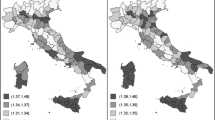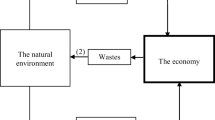Abstract
This paper examines the relationship between economic growth and environmental degradation in Ecuador from 1971 to 2010. We estimate this relationship in a country with a heavy reliance on revenue from the exploitation of natural resources, the depletion of vegetation cover in recent decades and a low level of participation of industry in GDP. We show the existence of an inverse relationship between real GDP and vegetation cover, indicating that the output of this country is based on environmental degradation. Through Johansen co-integration tests, we check that there is a relationship of long-term equilibrium between the first differences of real GDP, vegetal cover and the urbanization rate. The ECM shows that there is a short-term relationship between vegetation cover, the GDP and the rate of urbanization. Finally, we did not found Granger causality between the variables. A policy implication based on our findings is that policies to protect the environment should not jeopardize economic growth and not limit the rapid urbanization in the country.

Similar content being viewed by others
References
Acaravci, A., & Ozturk, I. (2010). On the relationship between energy consumption, CO2 emissions and economic growth in Europe. Energy Policy, 35(12), 5412–5420.
Adu, G. (2013). Effects on growth of environmental policy in a small open economy. Environmental Economics and Policy Studies, 15(4), 343–365.
Akaike, H. (1974). A new look at the statistical model identification. Automatic Control, IEEE Transactions on, 19(6), 716–723.
Akbostancı, E., Türüt-Aşık, S., & Tunç, Gİ. (2009). The relationship between income and environment in Turkey: Is there an environmental Kuznets curve? Energy Policy, 37(3), 861–867.
Alam, M. J., Begum, I. A., Buysse, J., & Van Huylenbroeck, G. (2012). Energy consumption, carbon emissions and economic growth nexus in Bangladesh: Cointegration and dynamic causality analysis. Energy Policy, 45, 217–225.
Al-Mulali, U. (2011). Oil consumption, CO2 emission and economic growth in MENA countries. Energy, 36(10), 6165–6171.
Ang, J. B. (2008). Economic development, pollutant emissions and energy consumption in Malaysia. Journal of Policy Modeling, 30(2), 271–278.
Apergis, N., & Payne, J. E. (2010). The emissions, energy consumption, and growth nexus: Evidence from the Commonwealth of Independent States. Energy Policy, 38(1), 650–655.
Arellano, M., & Bond, S. (1991). Some tests of specification for panel data: Monte Carlo evidence and an application to employment equations. The Review of Economic Studies, 58(2), 277–297.
Arouri, M. E. H., Youssef, A. B., M’henni, H., & Rault, C. (2012). Energy consumption, economic growth and CO 2 emissions in Middle East and North African countries. Energy Policy, 45, 342–349.
Azlina, A. (2011). On the causal links between energy consumption and economic growth in Malaysia. International Review of Business Research Papers, 7(6), 180–189.
Azlina, A. A. (2012). Energy consumption and economic development in Malaysia: A multivariate cointegration analysis. Procedia-Social and Behavioral Sciences, 65, 674–681.
Azlina, A., & Mustapha, N. H. (2012). Energy, economic growth and pollutant emissions Nexus: The case of Malaysia. Procedia-Social and Behavioral Sciences, 65, 1–7.
Bertinelli, L., Strobl, E., & Zou, B. (2012). Sustainable economic development and the environment: Theory and evidence. Energy Economics, 34(4), 1105–1114.
Bhattacharyya, R., & Ghoshal, T. (2009). Economic growth and CO2 emissions. Environment, Development and Sustainability, 12(2), 159–177.
Bhattarai, M., & Hammig, M. (2001). Institutions and the environmental Kuznets curve for deforestation: A cross-country analysis for Latin America, Africa and Asia. World Development, 29(6), 995–1010.
Central Bank of Ecuador. (2015). Central banking publications: Operations non-financial public sector. Recovered http://www.bce.fin.ec/index.php/component/k2/item/756.
Chang, C. C., & Carballo, C. F. S. (2011). Energy conservation and sustainable economic growth: The case of Latin America and the Caribbean. Energy Policy., 39(7), 4215–4221.
Cherniwchan, J. (2012). Economic growth, industrialization, and the environment. Resource and Energy Economics, 34(4), 442–467.
Chontanawat, J., Hunt, L. C, Pierse, R. (2006). Causality between energy consumption and GDP: Evidence from 30 OECD and 78 Non-OECD Countries. (No. 113). Surrey Energy Economics Centre (SEEC), School of Economics, University of Surrey.
Contreras, N. (2005). A comparative study of waste collection systems in Mexico and Sweden. Undergraduate Thesis. Department of Technology, Mathematics and Computer Science. University West.
Criado, C. O., Valente, S., & Stengos, T. (2011). Growth and pollution convergence: Theory and evidence. Journal of Environmental Economics and Management, 62(2), 199–214.
Cronin, R. P., & Pandya, A. (2009). Exploiting natural resources: Growth, instability, and conflict in the Middle East and Asia. Washington: Henry L. Stimson Center.
Dickey, D. A., & Fuller, W. A. (1979). Distribution of the estimators for autoregressive time series with a unit root. Journal of the American Statistical Association, 74(366a), 427–431.
Djezou, W. B. (2013). Optimal conversion of forest land to agriculture: Evidence from Côte d’Ivoire. Journal of Agricultural Studies, 1(2), 13–36.
Engle, R. F., & Granger, C. W. (1987). Co-integration and error correction: Representation estimation and testing. Econometrica: Journal of the Econometric Society, 55, 251–276.
Fæhn, T., & Bruvoll, A. (2009). Richer and cleaner—At others’ expense? Resource and Energy Economics, 31(2), 103–122.
Farhani, S., & BenRejeb, J. (2012). Energy consumption, economic growth and CO2 emissions: Evidence from panel data for MENA region. International Journal of Energy Economics and Policy., 2(2), 71–81.
Fodha, M., & Zaghdoud, O. (2010). Economic growth and pollutant emissions in Tunisia: An empirical analysis of the environmental Kuznets curve. Energy Policy., 38(2), 1150–1156.
Friedl, B., & Getzner, M. (2003). Determinants of CO2 emissions in a small open economy. Ecological Economics, 45(1), 133–148.
Galeotti, M. (2007). Economic growth and the quality of the environment: Taking stock. Environment, Development and Sustainability, 9(4), 427–454.
Ghosh, S. (2010). Examining carbon emissions economic growth nexus for India: A multivariate cointegration approach. Energy Policy., 38(6), 3008–3014.
Giovanis, E. (2013). Environmental Kuznets curve: Evidence from the British Household Panel Survey. Economic Modelling, 30, 602–611.
Granger, C. (1969). Investigating causal relations by econometric models and cross-spectral methods. Econometrica: Journal of the Econometric Society., 37(3), 424–438.
Gürlük, S. (2009). Economic growth, industrial pollution and human development in the Mediterranean Region. Ecological Economics, 68(8–9), 2327–2335.
Gutti, B., Aji, M., & Magaji, G. (2012). Environmental impact of natural resources exploitation in Nigeria and the way forward. Journal of Applied Technology in Environmental Sanitation, 2(2), 95–102.
Halicioglu, F. (2009). An econometric study of CO2 emissions, energy consumption, income and foreign trade in Turkey. Energy Policy, 37(3), 1156–1164.
Henderson, V. (2003). The urbanization process and economic growth: The so-what question. Journal of Economic Growth, 8(1), 47–71.
Hossain, S. (2012). An econometric analysis for CO2 emissions, energy consumption, economic growth, foreign trade and urbanization of Japan. Low Carbon Economy, 03(03), 92–105.
Hwang, J. H., & Yoo, S. H. (2014). Energy consumption, CO2 emissions, and economic growth: Evidence from Indonesia. Quality & Quantity, 48(1), 63–73.
Johansen, S. (1988). Statistical analysis of cointegrating vectors. Journal of Economic Dynamics and Control., 12, 231–254.
Johansen, S. (1991). Estimation and hypothesis testing of cointegrating vectors in gaussian vector autoregressive models. Econometrica: Journal of the Econometric Society, 59, 1551–1580.
Kuznets, S. (1955). Economic growth and income inequality. The American Economic Review, 45(1), 1–28.
Medina, M. (2010). Solid wastes, poverty and the environment in developing country cities challenges and opportunities. (No. 2010, 23). Working paper//World Institute for Development Economics Research.
Mehrara, M. (2007). Energy consumption and economic growth: The case of oil exporting countries. Energy Policy, 35(5), 2939–2945.
Menyah, K., & Wolde-Rufael, Y. (2010). Energy consumption, pollutant emissions and economic growth in South Africa. Energy Economics, 32(6), 1374–1382.
Ministry of Finances of Ecuador. (2015). Fiscal statistics. Fiscal statistics: Budgetary information. Recovered http://www.finanzas.gob.ec/estadisticas-fiscales/.
Munasinghe, M. (1999). Is environmental degradation an inevitable consequence of economic growth: Tunneling through the environmental Kuznets curve? Ecological Economics, 29(1), 89–109.
Narayan, P. K., & Narayan, S. (2010). Carbon dioxide emissions and economic growth: Panel data evidence from developing countries. Energy Policy, 38(1), 661–666.
Omri, A. (2013). CO2 emissions, energy consumption and economic growth nexus in MENA countries: Evidence from simultaneous equations models. Energy Economics, 40, 657–664.
Ozcan, B. (2013). The nexus between carbon emissions, energy consumption and economic growth in Middle East countries: A panel data analysis. Energy Policy., 62, 1138–1147.
Ozturk, I., & Acaravci, A. (2010). CO2 emissions, energy consumption and economic growth in Turkey. Renewable and Sustainable Energy Reviews, 14(9), 3220–3225.
Panayotou, T. (2003). Economic growth and the environment. Economic survey of Europe, pp. 45–72.
Pao, H. T., & Tsai, C. M. (2011). Modeling and forecasting the CO2 emissions, energy consumption, and economic growth in Brazil. Energy, 36(5), 2450–2458.
Phillips, P. C., & Perron, P. (1988). Testing for a unit root in time series regression. Biometrika, 75(2), 335–346.
Saboori, B., & Soleymani, A. (2011). CO2 emissions, economic growth and energy consumption in Iran: A co-integration approach. International Journal of Environmental Sciences, 2(1), 44–53.
Shaari, M. S., Hussain, N. E., & Ismail, M. S. (2012). Relationship between energy consumption and economic growth: Empirical evidence for Malaysia. Business Systems Review, 2(1), 17–28.
Shahbaz, M., Jam, F., Bibi, S., & Loganathan, N. (2015). Multivariate granger causality between CO2 emissions, energy intensity and economic growth in Portugal: evidence from co-integration and causality analysis. Technological and Economic Development of Economy. doi:10.3846/20294913.2014.989932.
Shahbaz, M., & Lean, H. (2012). Does financial development increase energy consumption? The role of industrialization and urbanization in Tunisia. Energy Policy, 40(7), 473–479.
Shahbaz, M., Lean, H., & Shabbir, M. (2012). Environmental Kuznets curve hypothesis in Pakistan: Cointegration and Granger causality. Renewable and Sustainable Energy Reviews, 16(5), 2947–2953.
Shahbaz, M., Mutascu, M., & Azim, P. (2013). Environmental Kuznets curve in Romania and the role of energy consumption. Renewable and Sustainable Energy Reviews, 18(2), 165–173.
Shahbaz, M., Tang, C., & Shabbir, M. (2011). Electricity consumption and economic growth nexus in Portugal using cointegration and Causality approaches. Energy Policy, 39(6), 3529–3536.
Silva, S., Soares, I., & Afonso, O. (2013). Economic growth and polluting resources: Market equilibrium and optimal policies. Economic Modelling, 30, 825–834.
Soytas, U., Sari, R., & Ewing, B. T. (2007). Energy consumption, income, and carbon emissions in the United States. Ecological Economics, 62(3–4), 482–489.
Stern, D. I. (2004). The rise and fall of the environmental Kuznets curve. World Development, 32(8), 1419–1439.
Stern, D. I., Common, M. S., & Barbier, E. B. (1996). Economic growth and environmental degradation: the environmental Kuznets curve and sustainable development. World Development, 24(7), 1151–1160.
Tiwari, A. (2011). Energy consumption, CO2 emissions and economic growth: evidence from India. Journal of International Business and Economy, 12, 85–122.
Whitley, S. (2013). Time to change the game: Fossil fuel subsidies and climate. London: Overseas Development Institute.
World Bank. (2015). Word development indicators: Countries and economies; Ecuador. Recovered http://data.worldbank.org/country/ecuador.
Zhang, X. P., & Cheng, X. M. (2009). Energy consumption, carbon emissions, and economic growth in China. Ecological Economics, 68(10), 2706–2712.
Author information
Authors and Affiliations
Corresponding author
Rights and permissions
About this article
Cite this article
Alvarado, R., Toledo, E. Environmental degradation and economic growth: evidence for a developing country. Environ Dev Sustain 19, 1205–1218 (2017). https://doi.org/10.1007/s10668-016-9790-y
Received:
Accepted:
Published:
Issue Date:
DOI: https://doi.org/10.1007/s10668-016-9790-y




